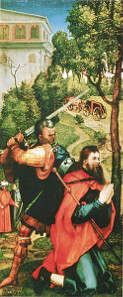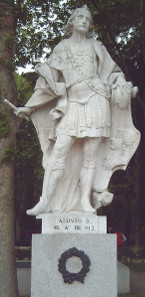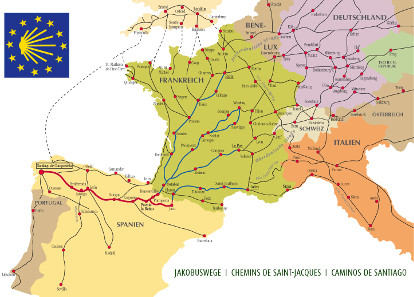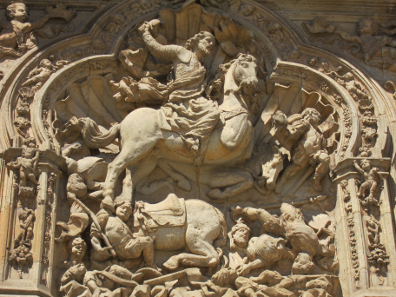translated by honeycutshome
The euro coins are a splendid means for all countries in the eurozone to convey their own self-conception. What does the pilgrimage to St. James mean to Spain? And what role did the Way of St. James play for European Christians of medieval times? Here you get the backdrop of the design of the Spanish 1, 2 and 5 cent coins.
On three denominations, Spain has a cathedral depicted that had been erected in Santiago de Compostela above the burial of Apostle Saint James at the end of the 11th century. By the look at the comparatively bare baroque façade it is hard to imagine that millions of people had the dream of going on a pilgrimage to this church in order to beseech Saint James to help and aid them.
Matyrdom of Apostle James. Detail of Heller Altarpiece by Albrecht Dürer. Source: Wikicommons.
Anyone reading the Acts of the Apostles carefully will be surprised at St. James ending up in Spain in the first place. After all, he suffered martyrdom in Jerusalem in A. D. 44, as the first of the 12 Apostles. Approximately 450 years later, a church was being built above his burial whose successive building can be viewed up to the present day in the Armenian quarter of Jerusalem. But what brought the Saint’s corpse to Santiago de Compostela in the first place? The Legenda Aurea, a medieval bestseller, informs us:
“And as Master John Beleth saith, which made this translation diligently: When the blessed Saint James was beheaded, his disciples took the body away by night for fear of the Jews, and brought it into a ship, and committed unto the will of our Lord the sepulture of it, and went withal into the ship without sail or rudder. And by the conduct of the angel of our Lord they arrived in Galicia in the realm of Lupa. … And then the disciples of Saint James took out his body and laid it upon a great stone. And anon the stone received the body into it as it had been soft wax, and made to the body a stone as it were a sepulchre.”
Then the disciples went to Lupa and requested a grave for James, but the lady was a stubborn pagan and a wicked sorceress. She sent the disciples to her bewitched, wild bulls that had killed anyone who had dared to approach them. The disciples were requested to yoke the bulls to the chariot in order to transport St. James to his burial site. But at the sight of James, the bulls became tame as lambs, and they willingly let themselves be yoked as if they were oxen and pulled the corpse to the spot the queen had determined. There, another danger awaited: a fierce dragon inhabited the place – by looking at the Saint, however, the creature burst asunder. When Lupa saw that she was so abashed that she immediately converted to Christianity and dedicated her palace into a church for St. James. According to the Legenda Aurea, the Saint was being laid there to rest. The pious tradition likewise has it that this place fell into oblivion, to be found again much later, in the 9th century, by a pious hermit. High above an abandoned Roman burial site he saw bright stars, hence the name Compostela – Campus stellae (= field of the star).
Statue of Alfonso III (c. 848-910) at the Plaza de Oriente in Madrid. Source: Luis García (Zaqarbal) / Wikicommons.
We don’t want to quarrel over beliefs but the fact remains that the sepulture of St. James is securely recorded for the first time as late as 885. That takes us right into an era when it was appropriate for the ruler over Northern Spain, i.e. Alfonso III, to have the burial site of such important a Saint in his territory. This is the early stage of the so-called Reconquista, the recapture of those parts of Spain that had been lost to Islamic rulers. Alfonso III had already gained first successes, but in order to expand his kingdom more effectively he promoted a proprietary church like the one the Frankish Empire had founded. A proprietary church is a construct in which the state head also functions as head of the churchly institution, being the one who appoints all high secular officials. It comes as no surprise that the Pope, who was already trying to assert his sovereignty, opposed that idea. Thus, it was quite convenient for Alfonso III to put forth the argument that his church was protected by an apostle just like the one in Rome. The Pope referred to Peter and Paul, and Alfonso to James. This political constellation laid the foundation of the cult of James the Greater. But it took something more to turn the local tradition of a small kingdom, located at the back of beyond, into a saint for the entire Christian world.
Cloak and staff (1571) of a pious pilgrim to Santiago de Compostela. Nuremberg, German National Museum. Photograph: Wolfgang Sauber / http://creativecommons.org/licenses/by-sa/3.0/deed.en
It was basically due to three factors that Santiago became the destination of all devoted Christians for centuries. The first and most important one was Cluny. This monastery in Burgundy became the center of a whole new kind of belief. While Christianity had been strongly shaped by pagan habits until the turn of the millennium, thanks to Cluny the search for God became a mass movement during the 11th and 12th centuries literally everyone joined, be it citizen or peasant, be it aristocrat or beggar; they all considered the intricacies of life and decided that it would be much better to acquire perpetual reward in the eyes of God than to keep the material storage chests well-filled. During these centuries, an immaculate and pious life became an ideal just like the one we modern people deem chic: having a trim figure, being tanned by the sun and at the same time working for at least 60 hours a week to be able to afford all kinds of things that admittedly nobody really needs in order to survive. At about that time, the passages had become safer due to political changes. The Europeans rediscovered travelling. Long-distance traders used the Roman streets and pilgrims set out to pray for the salvation of their soul at sacred sites. What were the destinations? Well, there was Rome to start with. And there was Jerusalem, the holy city; and this takes us to the third factor that made Santiago de Compostela turn into the most popular place of pilgrimage of all. The great competitor for this title, Jerusalem, had been conquered by Alp Arslan, Sultan of the Seljuq Empire, in 1070. Consequently, pilgrimages to Jerusalem were considered dangerous and unsafe, while safe Santiago became the most popular destination with Christians pilgrimaging.
Way of St. James. Source: Manfred Zentgraf / http://creativecommons.org/licenses/by-sa/2.5/deed.en
200,000 and 500,000 people went on a pilgrimage to St. James every year back then. The official church promising that one third of all sins would be atoned for automatically in turn, given true remorse was shown, very likely acted as an incentive to many. If the devoted pilgrim came to the Saint in a year his Saint’s day fell on a Sunday, he would have earned plenary indulgence and be able to enter paradise completely absolved. But not everyone who embarked on a journey to the then end of the world did so out of pious motivation. Many left their familiar surroundings out of love of adventure, and others had been sentenced to go on a pilgrimage to St. James after having committed a crime. We even have the wording of such a verdict: the accused person was sentenced to pilgrimage because he had offended his adversary with the words “monstrosity, bastard, sorcerer, theft, murderer and fire-raiser”.
What did such a pilgrimage cost and how long did it take? These questions are not easy to answer. We know that in Lübeck at the early 14th century between 10 and 40 mark were bequeathed to someone who went on a pilgrimage to the burial site of St. James in place of the deceased. The 10 mark were intended to finance not only one but two pilgrims at once. 10 mark: around 1220, that was the sum one had to pay in exchange for two oxen or twenty sheep. Around 1300, the prices probably were even higher. Hence, there were ways to realize a pilgrimage quite inexpensively, particularly against the backdrop that many rich and generous benefactors had founded charitable institutions along the Way of St. James where a pilgrim could stay the night and eat for free. How long a pilgrimage took of course depended on the pilgrim’s point of departure, on whether he traveled by horse or by foot, whether he was young and full of energy or, rather, old and weak. The believers came from throughout Europe. They walked every way and path, but over time four main pilgrimage routes evolved covering France with the most important Christian sanctuaries as stations. All these routes met in Puente La Reina, a bridge that had been built at the beginning of the 11th century on the initiative of the spouse of King Sancho III.
Bridges were a big help to the pilgrims since, as we are told by a medieval pilgrim’s guide: “…When boarding…one must be most careful not to fall by chance into the water….Many times the ferryman, having received his money, has such a large troop of pilgrims enter the boat that it capsizes and the pilgrims drown in the waves. Upon which the boatmen, having laid their hands upon the spoils of the dead, wickedly rejoice.”
From Puente la Reina, the pilgrim’s guide lists another 16 stops on the way but these probably couldn’t be managed in just 16 days, even more so if the pilgrim wanted to marvel at all the wonders and places of interest along the route.
Once the traveler had arrived at his destination, he threw the limestone he had picked up at the foot of the Cantabrian Mountains into the limestone oven that produced the lime required for building and preserving the Basilica of St. James. Afterwards and before entering the city, he took a purifying bath in a small forest located at the river. The forest bore the telling name ‘Lavamentula’ (literally: wash your private parts). The pilgrim’s guide seriously warns that the clothes might be stolen during ablutions. Leaving the river behind, one climbed the ‘Mount of Joy’. The pilgrim who spotted the Basilica of St. James first became pilgrim king. Up to the present day, many family names, like King or Leroy, hark back to these pilgrim kings. Upon entering the city the traveler bought a small scallop as evidence that he had reached the burial site of St. James and entered the church.
none
Cathedral of Santiago de Compostela. Photograph: KW.
Let us have a look at the edifice through the eyes of the medieval visitor: “It is an extraordinary work, with great space, bright, of fitting size, proportioned in its width, length and height, of extraordinary craft, with two levels like a royal palace. He who goes up to the upper galleries, if sad going up, will see the perfect beauty and will rejoice and be happy. … For health is given to the sick, vision to the blind, the tongue of the speechless is released, hearing is revealed to the deaf, health is given to the crippled, the possessed are liberated. And, what is more, prayers of the faithful are heard, their vows are taken up, the chains of sin are loosened, heaven is closed to those who assail it, solace is given to the sad, and people of all nations, from every part of the world, come trooping together bearing gifts of praise to the Lord.”
St. James – the “Moor Slayer”. Photograph: KW.
Strictly speaking, we ought to stop our elegiac praises right at this point because this is what Spain alludes to with its coin design. But we simply must mention that St. James also had a dark side. In Spain, James the Greater is also known as Matamoros, ‘Moor Slayer’. How come?
In 1089, Pope Urban II promised all Christian warriors willing to go to Spain in order to expel the Moors plenary indulgence in case of death. Thus, prior to the actual First Crusade to Jerusalem in 1095, an intra-European crusade was being launched. The bishop of Santiago, Gelmirez, who was in constant need of money, took advantage of the atmosphere and the conviction that the fight against the Moors was ordained by God. He created a diploma in which he invented an age-old tax in honor of St. James. The diploma states as reason for this contribution that once the Saint, riding a white horse, had intervened on behalf of the Spaniards in the Battle of Clavijo. That battle never really took place but the diploma brought the Saint the epithet Moor Slayer, which became bloody reality for hundreds of thousands of Indigos in South America when the Conquistadores slew entire peoples, on the cry “Santiago!”
On the modern Way of St. James. Photograph: KW.
Surely, these are not the things the coins depicting the Basilica of St. James are intended to recall. Rather, they ought to conjure the spirit of the High Middle Ages when members of all European nations went to Spain peacefully, to seek salvation. When Romanesque art spread in all of Europe, via the Way of St. James, and magnificent churches in the new style were erected along the pilgrimage routes. It is remarkable that such subject can be depicted on coins again, since let’s say 30 years ago it probably wouldn’t have been understood. The ’68 generation, however, calling everything traditional into question, have gotten long in the tooth, and esotericism has rediscovered the Way of St. James as the ‘Route of the Stars’ that promises self-discovery on immemorial streams of power. Their believers mingle with those who seek for an explanation of the meaning of their existence. Today, people again come in flocks to Santiago, not only from Europe but from all over the globe.
The feature film “The Way” (2010) tells the story of a father who decides to finish the pilgrimage for his son, who died walking it.
Or check out the award-winning documentary “Walking the Camino: Six ways to Santiago”.
“Bliss, Blisters and Beatification” – read an article by Spiegel International on the popular pilgrimage.












